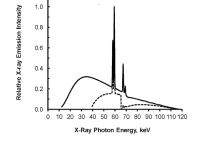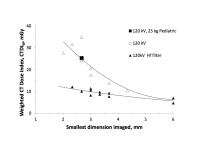
The Challenge: X-ray CT Medical Imaging has proven to be a very useful technique for observation of physical details inside of the human body. Unfortunately for young children, the Brenner Team of researchers at Columbia University has shown that the X-rays themselves can be dangerous. In large numbers the X-rays can create damaged cells in children that initiate a delayed form of fatal cancer, showing up at mid-life in a significant number of cases [1, 2]
The Solution: The solution to this challenge is to reduce the number of X rays used without reducing the observational capability. Historically, however, observational capability was improved by increasing the number of X-rays, increasing Contrast to Noise Ratio (C/NR), and allowing observation of smaller dimensions. The key, therefore, requires increasing contrast, and decreasing noise, while at the same time decreasing X-ray dose.
Increasing Contrast: Our Team of researchers has focused on increasing contrast. Installation of a Hafnium Filter in the exit window of the X-ray generating tube has been shown to narrow the X-ray photon energy spectrum, and thereby increase contrast, while at the same time decreasing X-ray dose by 40% to 50% [3].
Please see attachments:
1) Photograph of replacing the copper with hafnium in the center of the Exit Window Filter of the X-ray generating tube.
2) Figure showing the X-ray photon energy spectrum produced when 120kVp electrons strike a tungsten anode (solid curve), and calculated to be present after “filtering” by hafnium (dashed curve).
3) Figure showing the effect of using the hafnium filter. These data were taken observing a CIRS Model M007TE-04 tissue equivalent abdominal phantom, 10-year old size, custom modified to contain 1 to 6 mm dia. axial rods, with x-ray absorption properties 2% above the background matrix.
Decreasing Noise: CT system manufacturers have focused on the challenge by making use of “digital post-imaging iterative reconstructive techniques” to reduce noise. Sufficient noise reduction has been achieved to allow the X-ray dose to be reduced by 40% to 50%, a significant industry advance.
Increasing Contrast plus Decreasing Noise - Adding the hafnium filter contrast increase technique to a system using digital post-imaging iterative reconstructive noise reduction increases C/NR still further, and is projected by computational modelling to achieve a 90% reduction in X ray dose [4], truly making X ray CT safer for children. This combination is ready for optimization and adoption by CT system manufacturers.
References
1) Brenner DJ, Elliston CD, Hall EJ, Berdon WE. Estimated risks of radiation-induced fatal cancer from pediatric CT. AJR Am J Roentgenol. 2001;176:289-296.
2) Brenner DJ, et al. Estimating cancer risks from pediatric CT: going from qualitative to the quantitative. Pediatr Radiol. 2002;32:228-231.
3) Benz MG, Benz MW, Birnbaum SB, Chason E, Sheldon BW, McGuire D: Improved spatial resolution and lower-dose pediatric CT imaging: a feasibility study to evaluate narrowing the X-ray photon energy spectrum. Pediatr Radiol, 2014;44:1026-1030.
-
Awards
-
 2017 Top 100 Entries
2017 Top 100 Entries
Like this entry?
-
About the Entrant
- Name:Mark G Benz
- Type of entry:teamTeam members:Benz MG, Benz MW, Birnbaum SB, Chason E, Sheldon BW, McGuire D, Ebert GM, Beideck D
- Software used for this entry:Excel
- Patent status:patented








